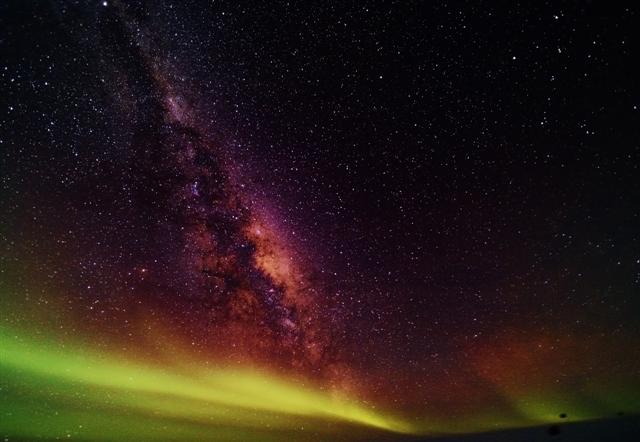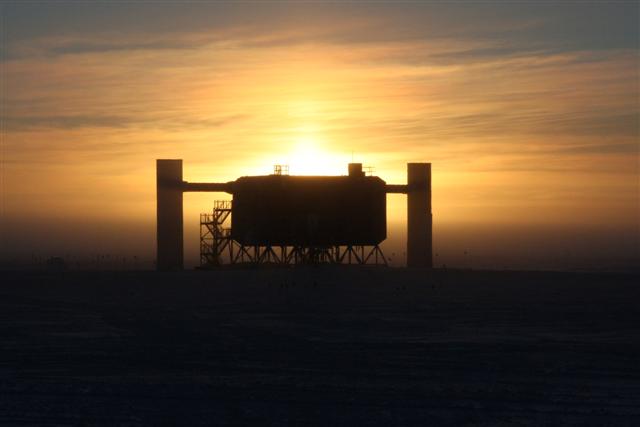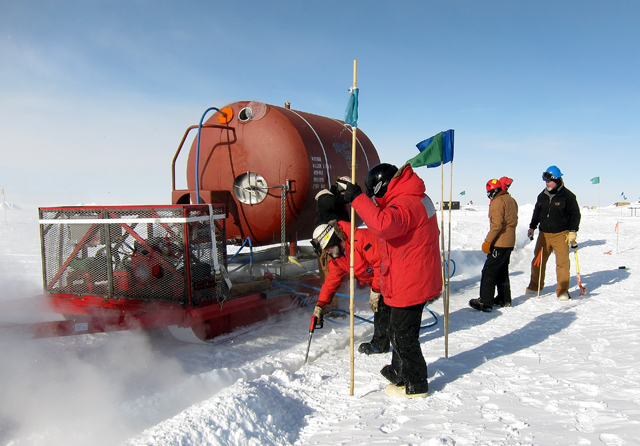Background noiseIceCube telescope makes unanticipated discovery about cosmic raysPosted August 6, 2010
Though still under construction, the IceCube Neutrino Observatory IceCube captures signals of notoriously elusive but scientifically fascinating subatomic particles called neutrinos. The telescope focuses on high-energy neutrinos that travel through the Earth, providing information about faraway cosmic events such as supernovas and black holes in the part of space visible from the Northern Hemisphere. However, one of the challenges of detecting these relatively rare particles is that the telescope is constantly bombarded by other particles, including many generated by cosmic rays interacting with the Earth’s atmosphere over the southern half of the sky. For most IceCube neutrino physicists these particles are simply background noise, but University of Wisconsin-Madison 
Photo Credit: Daniel Luong-Van/Antarctic Photo Library
The center of the Milky Way galaxy as seen from the South Pole.
“IceCube was not built to look at cosmic rays. Cosmic rays are considered background,” Abbasi said. “However, we have billions of events of background downward cosmic rays that ended up being very exciting.” Abbasi saw an unusual pattern when she looked at a “skymap” of the relative intensity of cosmic rays directed toward the Earth’s Southern Hemisphere, with an excess of cosmic rays detected in one part of the sky and a deficit in another. A similar lopsidedness, called “anisotropy,” has been seen from the Northern Hemisphere by previous experiments, she said, but its source is still a mystery. “At the beginning, we didn’t know what to expect. To see this anisotropy extending to the Southern Hemisphere sky is an additional piece of the puzzle around this enigmatic effect — whether it’s due to the magnetic field surrounding us or to the effect of a nearby supernova remnant, we don't know,” Abbasi said. The new results were published Aug. 1 in The Astrophysical Journal Letters, published by the American Astronomical Society One possible explanation for the irregular pattern is the remains of an exploded supernova, such as the relatively young nearby supernova remnant Vela, whose location corresponds to one of the cosmic ray hotspots in the anisotropy skymap. The pattern of cosmic rays also reveals more detail about the interstellar magnetic fields produced by moving gases of charged particles near Earth, which are difficult to study and poorly understood. Right now “we can predict some models, but we don’t have concrete knowledge of the magnetic field on small scales,” Abbasi said. “It would be really nice if we did — we would have made a lot more progress in the field.” 
Photo Credit: Keith Vanderlinde/Antarctic Photo Library
The IceCube laboratory building where data from the neutrino detector array feeds into.
Since nearly all cosmic signals are influenced by the interstellar magnetic fields, a better overall picture of these fields would aid a large range of physics and astronomy studies, she explained, adding that their newly reported findings rule out some proposed theories about the source of the Northern Hemisphere anisotropy. The IceCube group is currently extending its analysis to improve its understanding of the anisotropy on a more detailed scale and delve further into its possible causes. While the newly published study used data collected in 2007 and 2008 from just 22 strings of optical detectors in the IceCube telescope, they are now analyzing data from 59 of the 79 strings that are in place to date. When completed during the upcoming 2010-11 field season at the South Pole Station, the National Science Foundation “This is exciting because this effect could be the ‘smoking gun’ for our long-sought understanding of the source of high-energy cosmic rays,” Abbasi said.
NSF-funded research in this story: Francis Halzen and Albrecht Karle, University of Wisconsin-Madison, Award No. 0636875 |



For USAP Participants |
For The Public |
For Researchers and EducatorsContact UsU.S. National Science FoundationOffice of Polar Programs Geosciences Directorate 2415 Eisenhower Avenue, Suite W7100 Alexandria, VA 22314 Sign up for the NSF Office of Polar Programs newsletter and events. Feedback Form |


